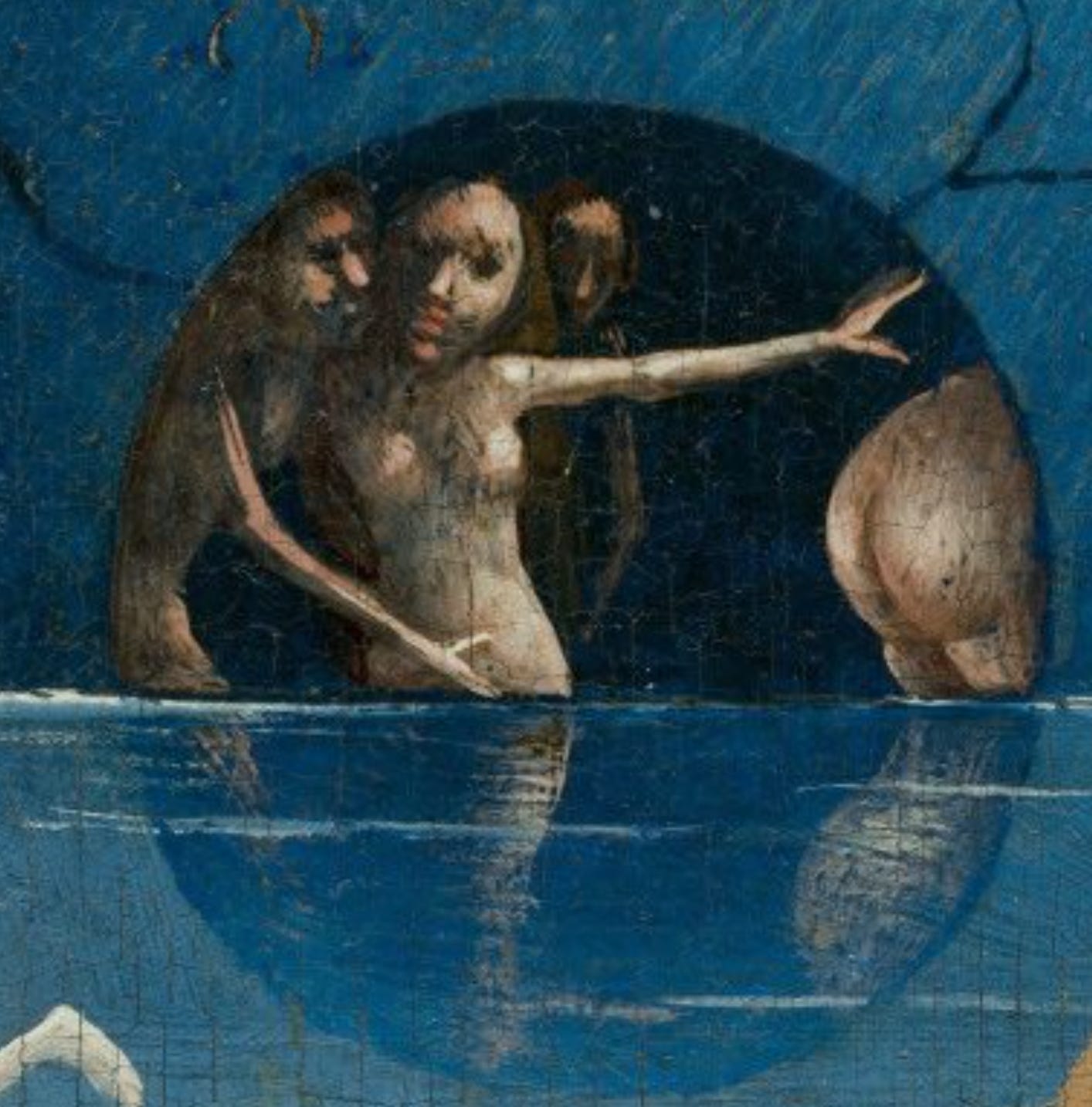5. Less Lust Than It Looks in the Garden of Delights.
'Unheard-of obscenities and perversions'? How times have changed.
The one thing critics agree on: the Garden of Earthly Delights is about sex. It’s about lewdness. It’s about libidinal excess, lust or Luxuria – the deadly sin Lust. It’s as though scholars have taken this scene below (which actually does display some pretty graphic lust) as typical of the whole painting.
Scholars have gone all-in on this interpretation of the centre panel.
Erwin Panofsky: ‘Unheard-of obscenities and perversions.’ Hans Belting: ‘Naked people . . . joyfully engaged in pleasures of the flesh.’ Walter Gibson: ‘the deadly sin of Lust.’ Carl Linfert: ‘Is it bliss the central panel depicts or a depraved orgy?’ Larry Silver: ‘Wanton intimacy . . . shameless sexual frankness’. Gary Schwarz: ‘Even the rocks and crystals are engaging in sex.’ Paul Vandenbroeck: ‘Addiction to lust’.
I may not have a PhD in 15th century Netherlandish art but – without going into the details – I do know something about lust. And when I go looking for it in any of these images I come up with much less than hoped.
What we have here is, to paraphrase Dr Evil, ‘quasi-lust . . . the margarine of lust . . . The Diet Coke of lust. Just one calorie. Not enough.’
Contrast this with the actual lust that we can actually see. This must be one of the most shocking pieces of sex art in the entire Renaissance.
These characters – unlike anyone or anything out there in the sunlight – have emerged from a Hades of mud and sludge, from the cavernous world of the Id. Bosch’s brushwork pushes her breasts up like a corset. Her mouth has all the underworld allure of a sex organ. The men have penis-like noses.
The fabulous Professor Koerner says the third man is about to enter her from behind right now (emphasis in the original). At maximum magnification, Bosch adds to his face a sinister glint of teeth; it gives him a lawless, predatory look.
Contrast this with the pale, pleasant, respectable people in the foreground of the Garden (below). If they were dressed, they would be at a garden fête. Prince Edward wouldn’t be out of place here. It’s impossible to think these nice people have anything in common with the threesome emerging from the darkness of the guts of lust.
What else is there in the painting, for actual lust? Here below in the white circle . . .
This man has boarded the cockleshell craft of a frozen blonde. He has purpose. He wants. He is in the process of possessing. The woman in the water, perhaps wife, girlfriend, conscience, is supplicating him. ‘Don’t do it! Come back!’
Both the vignettes are tiny. The Underworld people measure a few square inches in 92 square feet of triptych. You can barely see them from ten feet away.
And having examined these vignettes of lust, of people who really want, who demonstrate the urge to grip, grasp, penetrate and possess another person, we have come to the end of any full-fat lust in the triptych.
For all that critics want to urge on us the Biblical abhorrence of this deadly sin, Laurinda Dixon (art scholar, Bosch specialist) is surely right when she says: ‘The traditional iconography of lust is nowhere to be seen.’
Although – to be annoying – there is a sort of punishment for our threesome in the blue fountain. I think we get a glimpse of them in the right hand panel.
They may be the joyless demotivated trio in the Treeman’s hellish belly. Same penile noses, similar brushwork. Their punishment isn’t exactly severe. They have toads to sit on. There is drink provided. They are indoors. No impaling, severing, skewering, burning or blinding. They seem to be condemned to spend the rest of eternity with each other. Ah. Okay.
Back to the absence of Lust in the Garden.
Far from sexual excitement, the dominant mood in the foreground – below the hedge line – is disengagement, isolation, listlessness. It’s a dreamworld where people can’t or won’t make eye contact with each other.
This man is trying, but she is resolutely cutting him.
This poor dear is having a go, but everyone’s ignoring her.
Even in mid-embrace, his attention has been distracted
And in this noble, high-minded, group, all are unconnected . . .
. . . Except for the battered-looking man with the gourd – his sight line is directed at Madronho-Guzzling Gourd Man just over there. Maybe they have the basis of a relationship.
It’s definitely more a matter of liquor than lust in the Garden.
But to return to our beginning, it must be pointed out that even the threesome in the blue fountain have their erotic project undercut by the artist.
They have a comedy bottom pointing at them. That’s not an offer of anal sex, as the fabulous professor says. What we have here is mooning. And as the law says: ‘Comedy contra-indicates lust.’
NEXT TIME: We still haven’t finished looking for lust. But: 1) The ‘start of a depraved orgy’ – or a nice young man helping a woman to stand up? 2) Are the couple in the bubble about to ‘procreate the perfect being – or about to break up? 3) The upside down man – pornographic provocateur, or idiot?


















